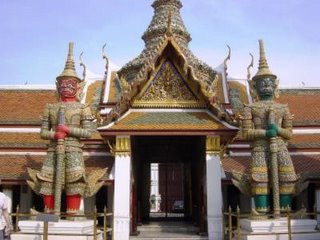A Brief History of Muaythai(Thai Boxing)Almost as ancient as the country itself, the art of Thai boxing is deeply ingrained in the history of Thailand. It is believed that the forbears of the modern Thai migrated from the South of China. In the course of their exodus, they had to hide from aggressive attackers and met with resistance from local people. A great number of battles had been fought and countless lives had been lost. The wars were fought using ancient weapons like bows, arrows, knives and spears. However, during the close-contact combat these weapons became cumbersome and thus arms, legs, elbows and knees were used to fight instead. These bodily weapons must have worked, because Muay Thai was later adopted as a required part of military training and became one of the skills expected of a real (brave) man in those days.
How it all began....
During the Ayudhya Period (1365 - 1768), Thailand (then Siam) had to fight a series of gruelling battles against neighbouring Burma, Cambodia and Vietnam. King Naresuan, ruling the country at the time, was a trained boxer himself. When he was captured during one of the battles, the King was given a chance to fight with Burma's top fighters in exchange for freedom. He returned to Siam as a hero and, not too long after, 'Siamese-style' boxing was recognised as a national sport. Muay Thai was at its zenith of popularity during the time of Pra Chao Sua (the Tiger King), when it was widely practiced in all levels of society. The King was well-known for his deep passion for Muay Thai and said to have participated incognito in various village contests and won many titles.
When Ayudhya fell, many Thais became Prisoners of War. One of them was a fighter named Nai Khanomtom. He was captured and taken to Rangoon, where he was requested by the King of Burma to fight against the Burmese champion. Nai Khanomtom prepared himself for the fight by performing the ritual 'Wai Khru'. When the fight began, he charged out at his opponent and quickly defeated him. The people were convinced that the Burmese opponent was distracted by the 'Wai Khru' and this rendered the knockout void. The King then asked Nai Khanomtom to fight again to prove himself, this time against nine other Burmese champions. Nai Khanomtom beat them all in a row and was granted freedom to return to Siam, where he had been a boxing legend since.
Muay Thai was banned during the 1920's due to an alarming rate of injury. However, it was later reinstated (1937) with a new set of rules for protecting contestants. And at the time of the Revolutionary Period permanent boxing stadiums were set up around the country, but they ceased to exist when World War II broke out. However, when the war ended, boxing stadiums re-appeared. In 1945, Thai people saw the advent of Rajdamnern Stadium, Thailand's very first standard boxing stadium.
Today, Muay Thai is said to be one of the deadliest forms of martial arts in the world. Although the number of participants have decreased over the years, Muay Thai is still a popular spectator sport. Television networks broadcast fights five days a week, and match results are reported in all major newspapers. International boxing is also very popular, and the country has produced dozens of world champions, who all started out as Muay Thai fighters though. Recently, many Thai films have been made to celebrate the art of Muay Thai. 'Beautiful Boxer' tells the story of a fascinating transvestite boxer while 'Ong Bak' and 'Tom Yum Goong' feature Tony Jaa, Muay Thai sensation who has been hailed as the new Jackie Chan. These films seem to have revived Muay Thai's popularity in Thailand and spreading the art of Muay Thai all over the world.

